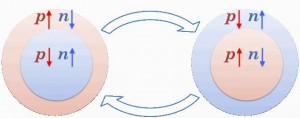Discovery of a new type of giant resonance in nuclei

A group including researchers from the Center for Nuclear Study, the University of Tokyo and the RIKEN Nishina Center has discovered a new giant-resonance state in lead (208Pb) and zirconium (90Zr) nuclei. This newly-confirmed state, an aspect of “isovector spin giant resonance” predicted theoretically in the 1970s, is termed “isovector spin monopole resonance” and is thought to be a manifestation of the nature of the atomic nucleus being composed of protons and neutrons possessing spin. Observation of this resonant state has long been anticipated since its excitation energy is related to basic properties of the nuclear force in nuclei and to the structure of neutron stars.

Schematic illustration of isovector spin monopole resonance. © Susumu Shimoura
Protons and neutrons with the same spin direction oscillate collectively.
The group developed a new research method using an unstable triton beam produced at the RI Beam Factory at RIKEN and for the first time succeeded in clearly confirming the existence of isovector spin monopole resonance. Experimentally determined excitation energies of the states in the two materials examined are reasonably reproduced by theoretical calculations assuming that the resonant state is brought about by a repulsive interaction. This discovery and the new research method developed here will lead us to a firmer understanding of high-density nuclear matter and the structure of neutron stars.
Press release (Japanese)
Paper
K. Miki, H. Sakai, T. Uesaka, S. Shimoura, et al.,
“Identification of the β+Isovector Spin Monopole Resonance via the 208Pb and 90Zr(t, 3He) Reactions at 300 MeV/u”,
Physical Review Letters 108, 262503 (2012), doi: 10.1103/PhysRevLett.108.262503.
Article link







